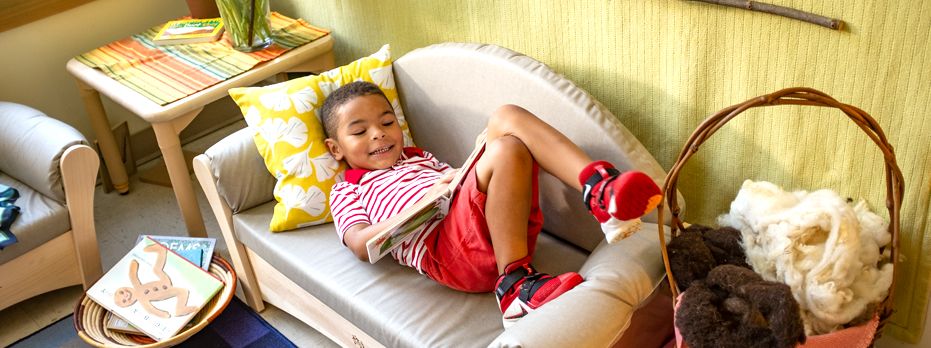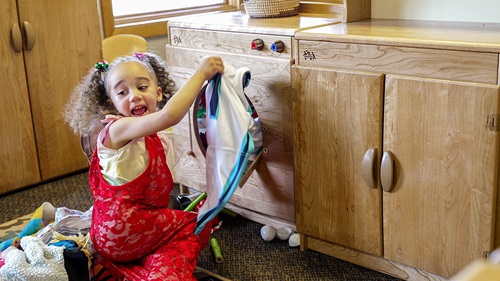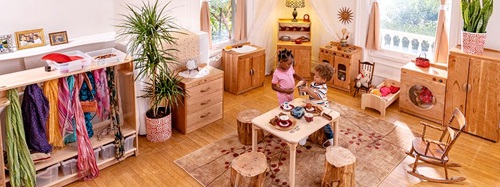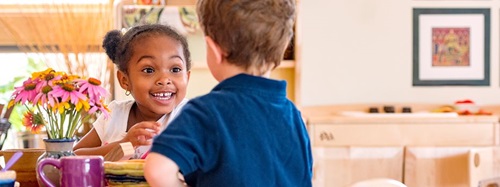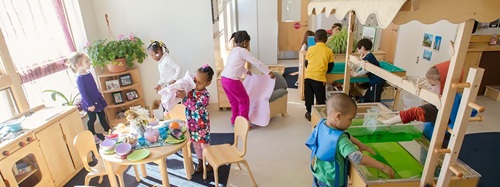Just Like Home
Why We Should Bring the Soft Stuff Back
| September 2008In the name of health, we have sterilized our Early Care and Education (ECE) environments. Healthy is good, but spending all day in spaces that offer no soft, cozy places for children and adults to enjoy comfortable, semi-private moments is like being in an institution. The soft elements bring a sense of home into the environment, a sense that one can get away from the group, to be alone or to share an intimate conversation with a friend. Children and adults need time to be away from the group and a safe place to observe the activities of colleagues and friends. This article presents an argument for soft, cozy spaces and offers suggestions for keeping them clean.
Let’s start with what we mean by soft elements. I am a big fan of a couch, an ottoman or a soft chair big enough for an adult to sit with 2-3 children. Cushions, foam mats and hammocks are great in the reading area and other cozy nooks that can be created in most ECE environments. Some adult seating in various areas of the room is guaranteed to boost staff morale as well as invite parents to watch their child at play. Window seats with cushions make for great adult and child seating; and, if made with easy to lift covers, become wonderful and much needed storage. Lofts can offer active play on top and cozy, protected space underneath. A low book shelf or cabinet with the door removed can be designated as a cozy child space. Even a plastic children’s pool with cushions inside can provide a wonderful contained quiet space. Use your imagination.
When thinking of soft elements, think also of the walls and ceilings. Awnings, canopies and tents are great ways of covering an area with soft light filtering through the material. Banners offer visual cues about where different activities are located. Quilts on the walls change the color of spaces, give a sense of warmth and containment and help reduce noise (a major health concern in child care). As a general rule, all furnishings and decorative elements should be simple in color. Clashing colors and patterns are visually distressing and can cause problems for children and adults who are easily over stimulated. However, I have seen very bright colors in Latin American and African American programs which work because they are part of the culture of the community.
Consider plants, both inside and in outdoor areas. Plants provide opportunities for nurturing growth and change. They also nurture us by improving the air quality in our indoor and outdoor spaces. They are soft to look at and emanate a sense of well-being.
A working definition of soft elements includes:
- seating for children and adults that is comfortable and located in areas of the room designated as quiet areas;
- seating for adults in eating areas, at the entrance to the room, and positioned around the room;
- warm and cozy respites, spaces that offer a sense of containment;
- soft visual elements that have the dual purpose of defining a space as well as helping to reduce noise; and,
- plants we can nurture and that nurture us by improving air quality.
What follows are the practical uses of soft elements, including how to keep them clean.
Let’s talk about where soft elements could be placed and how they add quality to our early care and education program philosophy and curriculum. High quality programs invite parent/family involvement. This begins with encouraging smooth transitions at the start and end of the day. Most parents are going to work so they are not going to sit on the floor or navigate their way down to a child’s chair. A couch, a chair, even a large ottoman placed near the entrance is both welcoming and invites parents to sit for a moment with their child. Having some age-appropriate books placed within easy reach offers a useful tool for sharing a quiet moment for both parent and child to ease into the separation. At the end of the day, it can be a blessing to the parent whose child is cranky or resists leaving usually because, like all of us, they want those they love to join in what they do during the day. Adult seating can also be a tool for teachers who want to encourage the ease of parent-child interaction. Consider this story:
An overweight, low energy mother arrives at the end of the day. Her very active four-year-old begins to run up and down the loft and slide. Her mother stands at the door looking miserable. Such tensions at separation and reunions are a daily occurrence and the teachers want to help. A teacher places an adult chair near the bottom of the slide and invites the mother to sit and relax. Once the mother is seated close to where her child is playing, the child begins to calm and within a few minutes she gets a book and sits in her mother’s lap. They read together. That day, they leave without conflict. It is not magic. It works because the chair allows the mother a comfortable place to be with her child. Once seated, the mother is giving her child the attention she needs in order to make the transition from group to home.
Soft Seating
Criteria for high quality care also emphasizes strong, trusting relationships between teacher and children. An adult chair, an ottoman, window seat or hammock invites teachers to sit with children, watching, engaging in conversation or holding a child who needs comfort. Adult chairs in the eating area are essential for babies to be individually fed or assisted in eating. Chairs make it easier for adults to create family-style eating while still having to get up and down to provide whatever is needed. A glider (well, everyone should have one of these) offers a magical sensory experience for the child having trouble settling down for a nap. Being on your feet all day is exhausting to most adults and bending over to pick up or talk to a child is a real occupational hazard. Comfortable adult seating encourages the kind of face to face interaction that builds strong trusting relationships as well as protecting the physical health and safety of teachers.
Healthier Environments
Group environments can be taxing for both children and adults. Group care is plagued by noise, air pollution and unhealthy lighting. Soft elements can help diminish these problems. Harsh, overhead lighting fixtures are common and inexpensive, but they have been found to increase stress and the frequency of headaches. If you consider how often the young child has to look up, it is obvious that they pose a risk to eye health. Noise levels in ECE rooms have been shown to cause hearing loss. Noise begets noise because when children are loud, teachers need to talk louder just to be heard. Wall hangings, rugs, and cushions help absorb noise. Soft elements, like awnings, canopies and tents, soften the glare of overhead lighting as well as reducing noise. Together, these additions to ECE environments make life in group care more enjoyable and healthier for all.
Having corners of relative quiet comfort can help ease the pressures of constant interaction. There is a sense of home that is comforting to children, teachers and parents. Window seats offer places to look over the environment or out the window from a higher perspective. They offer the young toddler a place to hold onto while practicing standing and walking. Mats with vinyl covers make excellent seating inside or outside; but they have the added advantage of being used for tumbling and other large motor activities.
Soft and Clean
Keeping soft elements clean is too often the argument used to keep them from the classroom. Fabrics, like cotton sheets, coverlets, or any washable throw can be used to cover couches, easy chairs or over foam mats. Parachute material is wonderful for making tents or canopies. It rarely needs to be washed but does need to be dusted. You have to look at your state regulations as well as fire codes when hanging anything from the ceiling. Cushions should be removable as well as easily washed. Fabrics can be sprayed to resist staining and allow for sponge cleaning. Most cleaning and stain-protecting products are toxic and are best left to completely air out before returning to the classroom. Plants just need to be dusted.
Just Like Home
The benefits of soft elements in ECE environments far outweigh the challenges of keeping them clean. They support the needs of both children and adults for comfortable, quiet spaces. They reduce noise, help clean the air and soften the harsh glare of overhead lighting. They support the curriculum by encouraging parent involvement and teacher child interaction. It takes imagination and a keen eye for nooks that can become protected quiet spaces. It takes planning and careful selection of materials to ensure a routine cleaning schedule. But it is worth it – our teachers and young children are worth it. Let’s keep our ECE environments as home-like as we can.

